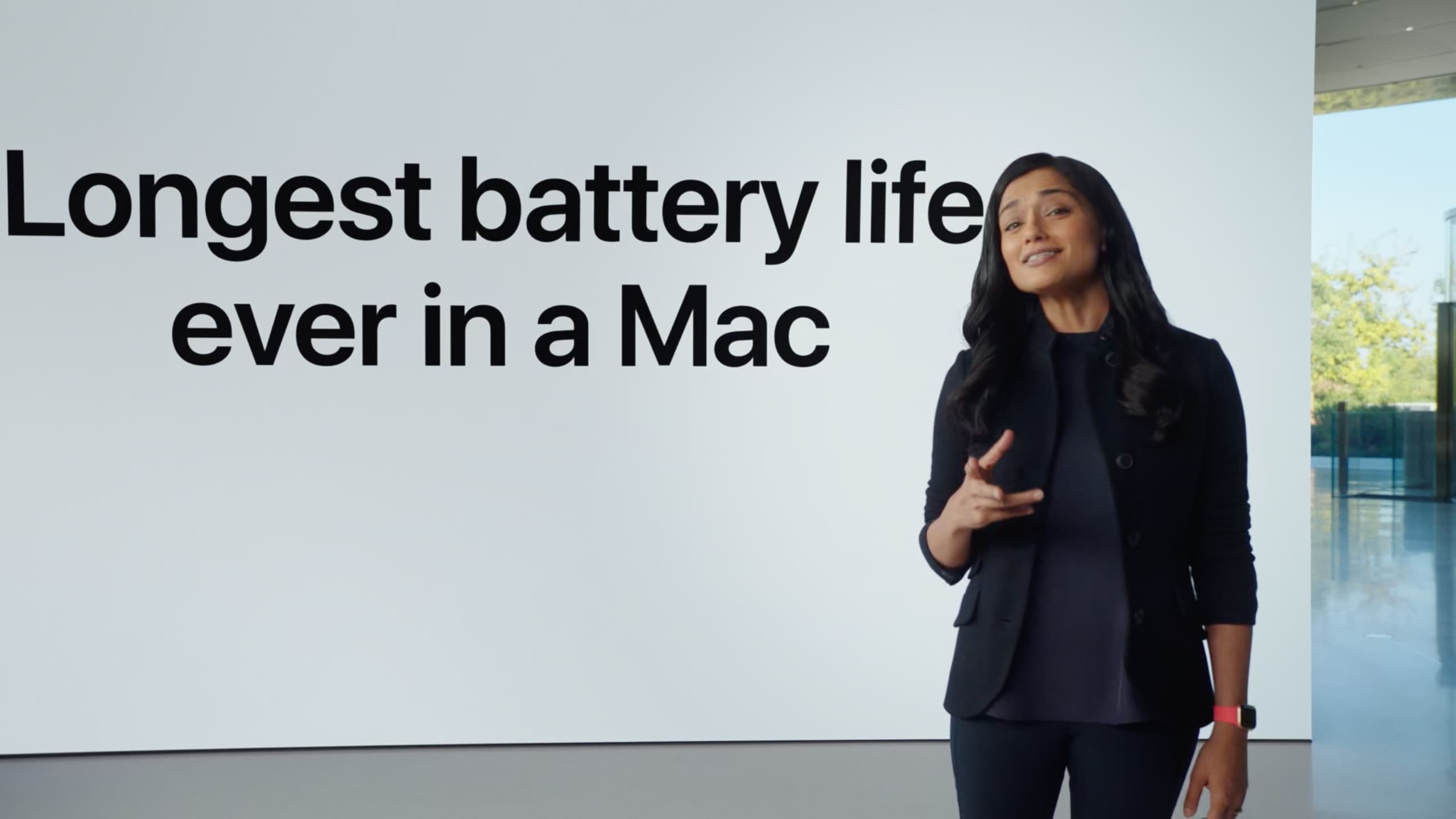Apple Silicon was widely expected to be fast, but perhaps the biggest surprise of the new M1 chip is the insane battery life it enables.
During Tuesday’s “One More Thing” keynote, Apple touted some truly eye-popping battery life numbers. While we expected improved battery life from the new MacBooks, the numbers Apple released surpassed expectations.
The new MacBook Air, for example, can run for up to 15 hours while browsing the web wirelessly. It will run for up to 18 hours while playing videos.
Compare this to the previous Air, which lasted for 11 hours when web browsing and 12 hours when watching movies.
That’s up to an extra six hours of battery life — almost a full working day.
What about the MacBook Pro?
The battery life in the new MacBook Pro is even better.
The new MacBook Pro’s battery will run for up to 17 hours when web browsing and up to 20 hours when playing video. The previous-generation MacBook Pro ran for up to 10 hours when browsing the web and up to 10 hours when watching movies. That’s an improvement of 7 hours and 10 hours, respectively.
According to Apple, the improvements are the “longest battery life ever in a Mac.”
“The battery is generally more time than I spend awake in a day,” Conor Russomanno, a neurotechnologist and one of Apple’s early testers, said in a promotional video played during the event.
While the Air features a 49.9 WHr battery, and the Pro comes with a 58.2 WHr battery, both machines are powered by Apple’s new M1 chip, the first Apple Silicon CPU.
The secret? High-efficiency cores
The extra battery life is achieved largely by the M1’s four high-efficiency cores. These four cores are roughly equivalent in performance to an older dual-core Intel MacBook Air, but operate at much lower power. These four cores run simple, low-performance tasks like browsing the web or writing email.
When the user engages in more intensive tasks, like building a 3D model or editing video, the M1 engages its four high-performance cores for to boost the power. According to Apple, the M1 boasts up to 3.5x faster CPU, 6x faster GPU, and 15x faster machine learning.
The upsell
While Apple’s event featured a lot of technical info about the new chips, battery life is an easy-to-understand metric for most consumers — and a big factor in buying decisions. Almost doubling battery life should be an easy sell.
“Advancements of this magnitude only come from making bold changes,” said Apple CEO Tim Cook at the conclusion of the event.

Leander Kahney is the editor and publisher of Cult of Mac.
Leander is a longtime technology reporter and the author of six acclaimed books about Apple, including two New York Times bestsellers: Jony Ive: The Genius Behind Apple’s Greatest Products and Inside Steve’s Brain, a biography of Steve Jobs.
He’s also written a top-selling biography of Apple CEO Tim Cook and authored Cult of Mac and Cult of iPod, which both won prestigious design awards. Most recently, he was co-author of Cult of Mac, 2nd Edition.
Leander has been reporting about Apple and technology for nearly 30 years.
Before founding Cult of Mac as an independent publication, Leander was news editor at Wired.com, where he was responsible for the day-to-day running of the Wired.com website. He headed up a team of six section editors, a dozen reporters and a large pool of freelancers. Together the team produced a daily digest of stories about the impact of science and technology, and won several awards, including several Webby Awards, 2X Knight-Batten Awards for Innovation in Journalism and the 2010 MIN (Magazine Industry Newsletter) award for best blog, among others.
Before being promoted to news editor, Leander was Wired.com’s senior reporter, primarily covering Apple. During that time, Leander published a ton of scoops, including the first in-depth report about the development of the iPod. Leander attended almost every keynote speech and special product launch presented by Steve Jobs, including the historic launches of the iPhone and iPad. He also reported from almost every Macworld Expo in the late ’90s and early ‘2000s, including, sadly, the last shows in Boston, San Francisco and Tokyo. His reporting for Wired.com formed the basis of the first Cult of Mac book, and subsequently this website.
Before joining Wired, Leander was a senior reporter at the legendary MacWeek, the storied and long-running weekly that documented Apple and its community in the 1980s and ’90s.
Leander has written for Wired magazine (including the Issue 16.04 cover story about Steve Jobs’ leadership at Apple, entitled Evil/Genius), Scientific American, The Guardian, The Observer, The San Francisco Chronicle and many other publications.
Leander has a postgrad diploma in artificial intelligence from the University of Aberdeen, and a BSc (Hons) in experimental psychology from the University of Sussex.
He has a diploma in journalism from the UK’s National Council for the Training of Journalists.
Leander lives in San Francisco, California, and is married with four children. He’s an avid biker and has ridden in many long-distance bike events, including California’s legendary Death Ride.
You can find out more about Leander on LinkedIn and Facebook. You can follow him on X at @lkahney or Instagram.


